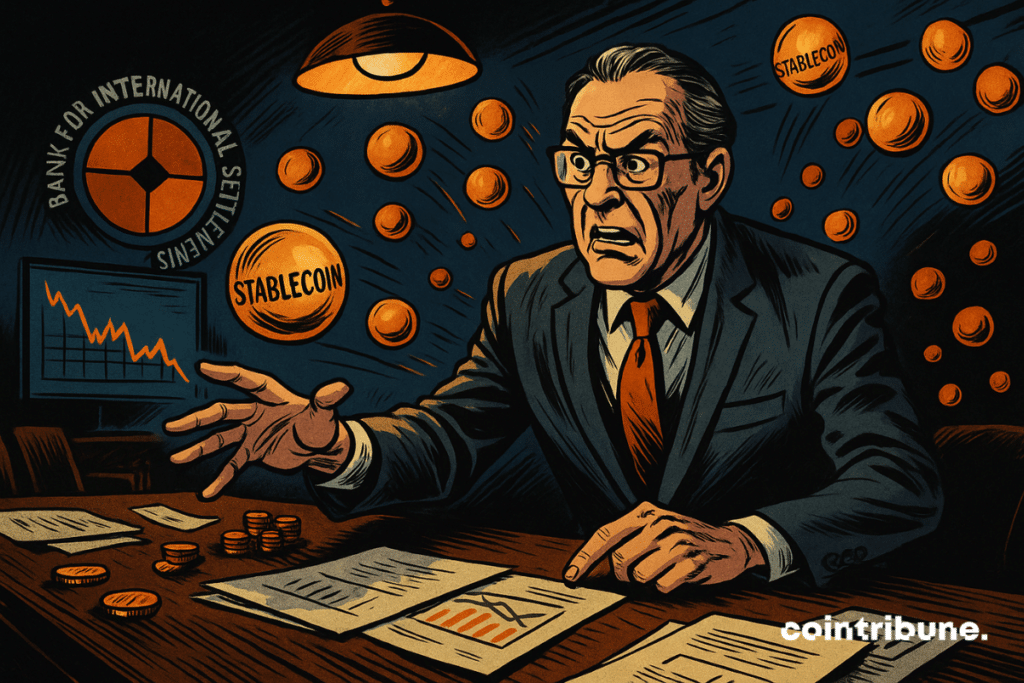The BIS Considers Stablecoins Ineffective And Dangerous For The Global Economy: Here’s Why
Stablecoins, these digital tokens backed by fiat currencies, are often seen as a bridge between volatile cryptos and monetary stability. For many, they represent an obvious solution to the instability of digital assets. The European Union, the United States, and other major economies are betting big on these hybrid tools. Yet, the Bank for International Settlements (BIS) has just cast a chill. In its 2025 annual economic report, it paints a much less flattering picture.

In brief
- The BIS criticizes stablecoins for their lack of universality, flexibility, and financial security.
- Their issuance still requires advance payment, limiting their use in economic shocks.
- Stablecoins are deemed vulnerable to fraud, money laundering, and sanctions evasion by the BIS.
- Tokenization, on the other hand, receives the BIS’s favor as an innovation for a more regulated finance.
A triple failure according to the BIS: illusory stability and dubious security
The BIS does not mince words. For it, stablecoins fail on three essential points: “singleness,” “elasticity,” and “integrity”. These three criteria define a reliable currency in a modern economy. According to its terms, stablecoins would be nothing more than “digital bearer instruments“, closer to a financial asset than to real money.
Unlike money issued by central banks, accepted “at par” and everywhere without friction, stablecoins are issued by private entities. This creates disparity in usage and trust. Some stablecoins even trade with value gaps. The promised universality collapses. Regarding elasticity, the BIS points out that “additional issuance requires full prior payment from its holders“. Nothing like central banks, which can adjust the money supply in case of crisis.
And what about integrity? Again, it is a no. According to the report, “stablecoins have significant gaps in promoting the integrity of the monetary system“. The lack of clear KYC/AML standards makes their use risky, even criminal. Money laundering, terrorist financing, sanctions evasion… the blacklist is long.
Stablecoins vs banks: a return to the 19th-century future
A passage in the BIS report sends a shiver down the spine: “stablecoins resemble the private banknotes of 19th-century United States“. At that time, each bank issued its own currency. Result: instability, fraud, bank panic. This step backward is worrying. Stablecoins are not subject to the same guarantees as a traditional bank deposit. Hence the Basel institution’s warnings.
A tweet by Angelica Saldaña nicely summarizes this lexical fracture:
In banking, we don’t talk about stablecoins; we talk about tokenized deposits.
Behind this nuance lies a strategy of retaking control by the authorities: repackaging innovation into a regulated tool.
The BIS is not against innovation. On the contrary, it praises tokenization, which consists of digitizing traditional assets on a blockchain. In its tweet of June 25, it states: “tokenization is a transformative innovation to improve the old and enable the new”.
A tokenized platform including central reserves, government bonds, and commercial currency would, according to it, be the future of the financial system.
Crypto: the crazy numbers and risky bets of the new monetary Far West
The BIS’s firm stance does not mean the end of stablecoins. Their use continues to grow, especially in countries where access to the dollar is restricted. Their advantages are real: low cost, cross-border accessibility, settlement speed.
The United States, through several institutions, does not share the BIS’s radical view. The debate is open. What is at stake goes beyond technology; it is a matter of monetary sovereignty.
Key figures to remember:
- More than 15% drop for Circle’s (CRCL) stock after the BIS report publication;
- The potential stablecoin market is estimated at 2 trillion dollars according to the U.S. Treasury;
- 600% increase for CRCL since its IPO, before the correction;
- About 25 billion dollars in daily stable transactions according to March 2025 data;
- 70% of the DeFi market is backed by stablecoins.
In the long term, the battle promises to be as ideological as technological. The word “stablecoin” is becoming a semantic battleground.
Stablecoins are divisive. On one side, the BIS warns against systemic risks. On the other, the United States, the world’s largest economy, bets on a $2 trillion market supported by these assets. The future will not be fixed. But the lines are indeed moving.
Maximize your Cointribune experience with our "Read to Earn" program! For every article you read, earn points and access exclusive rewards. Sign up now and start earning benefits.
La révolution blockchain et crypto est en marche ! Et le jour où les impacts se feront ressentir sur l’économie la plus vulnérable de ce Monde, contre toute espérance, je dirai que j’y étais pour quelque chose
The views, thoughts, and opinions expressed in this article belong solely to the author, and should not be taken as investment advice. Do your own research before taking any investment decisions.